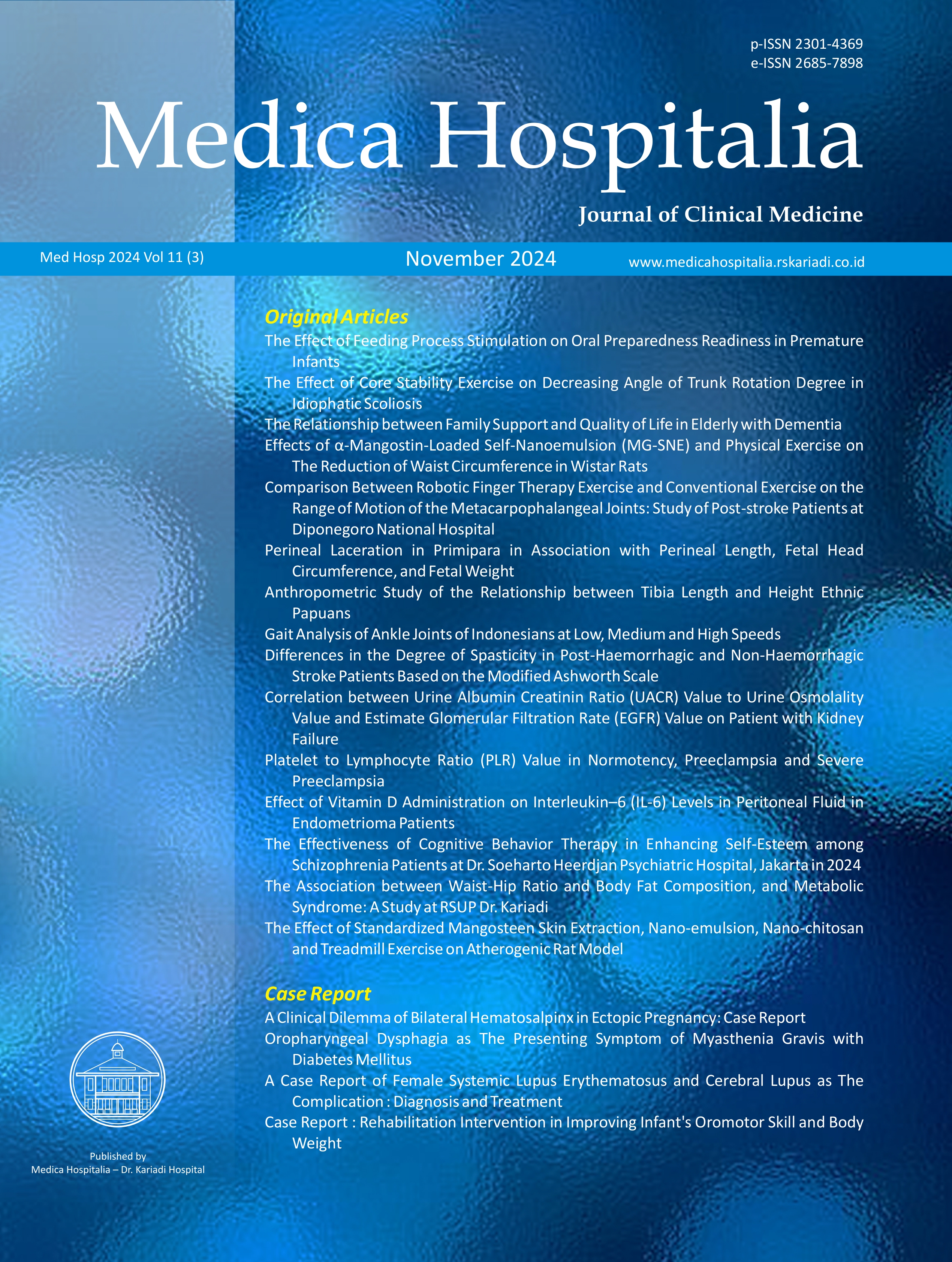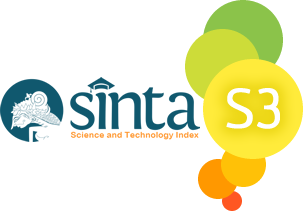Radiologic Features Of Anencephaly : A Serial Case Report
DOI:
https://doi.org/10.36408/mhjcm.v12i1.1186Keywords:
Anencephaly, neural tube defect, UltrasonographyAbstract
Background : Anencephaly is a lethal central nervous system anomaly characterized by absence of cerebral structures and cranial vault. It is the most common open neural tube defect that occurs in 0.5 – 2 per 1,000 live births. This anomaly can be detected as early as 11 weeks of pregnancy by transvaginal ultrasonography. Micronutrient deficiency, such as anemia and folic acid deficiency, was known to be the potential risk factor for anencephaly.
Case Report : We reported 4 cases of anencephaly diagnosed using ultrasonography during pregnancy. All patients were referred to Dr. Kariadi General Hospital from private hospitals in Central Java. 3 out of 4 cases were diagnosed in the first trimester and 1 case was diagnosed in the third trimester. Ultrasonography features showed typical signs of anencephaly including ‘frog eyes sign’, ‘Mickey mouse sign’ and acrania. All of the patients underwent termination of pregnancy with variable route of delivery according to each patients’ condition and gestational age.
Discussion : Routine antenatal ultrasonography is recommended for early detection of fetal viability and other congenital anomalies including anencephaly. Ultrasonography is able to detect typical findings of anencephaly and therefore is able to accurately establish the diagnosis. Advanced imaging technique such as MRI is unnecessary unless diagnosis using ultrasonography is indeterminate. Establishing the diagnosis of anencephaly is very important due to determining its definitive treatment, in which termination of pregnancy.
Conclusion : In this serial case series, we present various radiologic features of anencephaly using ultrasonography so that clinicians will be able to diagnose this anomaly in earlier age of pregnancy. Hence, definitive treatment can be done and complications during pregnancy can be prevented.
Downloads
References
1. Salari N, Fatahi B, Fatahian R, Mohammadi P, Rahmani A, Darvishi N, et al. Global prevalence of congenital anencephaly: a comprehensive systematic review and meta-analysis. Reprod Health. 2022;19(1):201.
2. Abebe M, Afework M, Emamu B, Teshome D. Risk factors of anencephaly: a case-control study in Dessie Town, North East Ethiopia. Pediatr Health Med Ther. 2021;12: 499–506.
3. Reddy R. Ultrasonography diagnosis of acrania–exencephaly sequence at 22 weeks gestation. Muller J Med Sci Res. 2022;13(2):114.
4. Moussaoui KE, Bakkali SE, Ghrab I, Baidada A, Kharbach A, Moussaoui KE, et al. Anencephaly: case report and literature review. J Gynecol Res Obstet. 2021;7(1):5–7.
5. Osborn AG, Hedlund GL, Salzman KL. Osborn’s brain. 2nd ed. Philadelphia, PA: Elsevier; 2017.
6. Atlas SW. Magnetic resonance imaging of the brain and spine. 5th ed. Philadelphia: LWW; 2016.
7. Finkelstein JL, Fothergill A, Johnson CB, Guetterman HM, Bose B, Jabbar S, et al. Anemia and vitamin B-12 and folate status in women of reproductive age in Southern India: estimating population-based risk of neural tube defects. Curr Dev Nutr. 2021;5(5).
8. Kancherla V, Chadha M, Rowe L, Thompson A, Jain S, Walters D, et al. Reducing the burden of anemia and neural tube defects in low- and middle-income countries: an analysis to identify countries with an immediate potential to benefit from large-scale mandatory fortification of wheat flour and rice. Nutrients. 2021;13(1):244.
9. Barkovich AJ, Raybaud C. Pediatric neuroimaging. 6th ed. Philadelphia: LWW; 2018.
10. Masselli G, Vaccaro Notte MR, Zacharzewska-Gondek A, Laghi F, Manganaro L, Brunelli R. Fetal MRI of CNS abnormalities. Clin Radiol. 2020;75(8):640.
11. Munteanu O, Cîrstoiu MM, Filipoiu FM, Neamţu MN, Stavarache I, Georgescu TA, et al. The etiopathogenic and morphological spectrum of anencephaly: a comprehensive review of literature. Rom J Morphol Embryol. 2020;61(2):335–43.
12. Monteagudo A. Exencephaly-anencephaly sequence. Am J Obstet Gynecol. 2020;223(6): B5–8.
13. Szkodziak P, Krzyżanowski J, Krzyżanowski A, Szkodziak F, Woźniak S, Czuczwar P, et al. The role of the “beret” sign and other markers in ultrasound diagnostic of the acrania–exencephaly–anencephaly sequence stages. Arch Gynecol Obstet. 2020;302(3):619–28.
14. Jumbo AI, Nonye-Enyidah EI. A case of anencephaly in an unbooked primipara diagnosed at 35 weeks gestation. World J Adv Res Rev. 2021;12(2):555–8.
15. Chen Y, Wang X, Lu S, Huang J, Zhang L, Hu W. The diagnostic accuracy of maternal serum alpha-fetoprotein variants (AFP-L2 and AFP-L3) in predicting fetal open neural tube defects and abdominal wall defects. Clin Chim Acta. 2020;507: 125–31.
16. Mangla M, Anne RP. Perinatal management of pregnancies with fetal congenital anomalies: a guide to obstetricians and pediatricians. Curr Pediatr Rev. 2024;20(2):150–65.
Additional Files
Published
How to Cite
Issue
Section
Citation Check
License
Copyright (c) 2025 Nadia Citradibyaguna, Besari Adi Pramono, Farah Hendara Ningrum, Sukma Imawati (Author)

This work is licensed under a Creative Commons Attribution-ShareAlike 4.0 International License.
Copyrights Notice
Copyrights:
Researchers publishing manuscrips at Medica Hospitalis: Journal of Clinical Medicine agree with regulations as follow:
Copyrights of each article belong to researchers, and it is likewise the patent rights
Researchers admit that Medica Hospitalia: Journal of Clinical Medicine has the right of first publication
Researchers may submit manuscripts separately, manage non exclusive distribution of published manuscripts into other versions (such as: being sent to researchers’ institutional repository, publication in the books, etc), admitting that manuscripts have been firstly published at Medica Hospitalia: Journal of Clinical Medicine
License:
Medica Hospitalia: Journal of Clinical Medicine is disseminated based on provisions of Creative Common Attribution-Share Alike 4.0 Internasional It allows individuals to duplicate and disseminate manuscripts in any formats, to alter, compose and make derivatives of manuscripts for any purpose. You are not allowed to use manuscripts for commercial purposes. You should properly acknowledge, reference links, and state that alterations have been made. You can do so in proper ways, but it does not hint that the licensors support you or your usage.
























